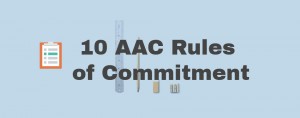10 AAC Rules of Commitment

Rule 1: Be committed to the most effective communication system for the individual being served.
Rule 2: Be committed to following your professional code of ethics.
Rule 3: Be committed to involving the consumer and family in the service delivery process.
Rule 4: Be committed to achieving the maximum outcomes for the individual.
Rule 5: Be committed to advocating for language.
Rule 6: Understand the merits of ALL AAC language representation methods. (Be able to discuss and demonstration how language is represented using an Speech Generating Device [SGD])
Rule 7: Support the language representation method(s) for core and extended vocabulary access that best serve the interest of the individual.
Rule 8: Advocate for the AAC system that supports the chosen language representation method(s).
Rule 9: Be committed to using AAC performance measurement to support clinical intervention.
Rule 10: If unable to adhere to any of these guidelines, be truthful about it to the individual, family, and advocates.
The 10 AAC Rules of Commitment were published first as a three part series in the 1999 October, November and December editions of Exceptional Parent. The rules are supported with evidence including performance data of AAC speakers. These rules lay the foundation for the resources, services and advocacy efforts of the AAC Institute and ICAN™ Talk Clinic. The following content briefly discusses the importance of each rule and can be used as guideposts in evaluating the AAC system, services and supports an individual is receiving.
Rule 1: Be committed to the most effective communication system for the individual being served.
The AAC assessment may be the single most important event in the life of a person who relies on AAC. Where that person goes in life will be influenced by communication effectiveness.
Rule 2: Be committed to following your professional code of ethics.
All members of the team must not only agree, but be motivated to provide the system and services that result in the highest level of personal achievement. In addition, the team must be working toward helping the person develop communicative competence which results in a spontaneous, interactive exchange of information, feelings, and thoughts. Family members should be asking team members how their educational and/or treatment plan and recommendations are going to help their family member communicate effectively.
Rule 3: Be committed to involving the consumer and family in the service delivery process.
A Consumer-Centered Service Delivery model places the team members and processes in proper perspective. The consumer and family are the focal point and families may even decide to request outside supports. Each person on the team has a contributing role in achieving the identified outcomes. Outcomes are influenced by the environment. Defining the roles and responsibilities of the individual team members in this model can have a positive influence on Rule 4.
Rule 4: Be committed to achieving the maximum outcomes for the individual.
Stakeholders are those with an interest in the outcomes of the process. Stakeholders in the AAC service delivery process include the service delivery team and others, including administrators, funding agencies, etc. Families need to realize that because of different roles and responsibilities, some stakeholders are vested in achieving different outcomes. Clinicians and therapists tend to be more concerned with outcomes related to clinical results and functional status. Whereas, administrators and funding agencies will be more concerned with best use of staff time and cost effectiveness for service delivery. Consumers and family members have concerns connected to quality of life and satisfaction issues.
Rule 5: Be committed to advocating for language.
If the team agrees on the central goal of AAC as being the highest possible personal achievement, then language becomes the focus of assessment and intervention. Little language learning is possible when no provisions are made to explore and create self-generated utterances. Families need to ask questions about the ability of the intervention will facilitate language growth and not just foster routine behaviors and compliance to tasks. A sure sign of a behavior focus to therapy is the prevalence of nouns and other words that would be used to make requests.
Rule 6: Understand the merits of ALL language representation methods.
The three commonly used AAC language representation methods (LRMs) are alphabet-based methods (spelling), single meaning pictures, and multi-meaning icons (semantic compaction). The outcomes an individual who relies on AAC is able to achieve depend heavily on how language is represented and generated. Ease of use at first encounter may not be most effective in the long run. Published evidence identifies the performance differences that exist among LRMs.
Rule 7: Support the language representation method(s) for core and extended vocabulary access that best serve the interest of the individual.
Access to a vocabulary based on the notion of core and extended categories is critical to being able to say what you want to say. The vast majority (approximately 80%) of words we use in daily conversations consists of a few hundred core words for example pronouns, verbs, prepositions, questions words. Core words are NOT nouns!
Rule 8: Advocate for the AAC system that supports the chosen language representation method(s).
Most individuals reaching the goal of AAC are using multiple language representation methods with the AAC system. Observation of their achievement indicates the use of semantic compaction for core vocabulary access and spelling for extended vocabulary words. Single meaning pictures appear to have limited use for when the individual only requires access to a small core vocabulary set or for access to extended vocabulary when the individual cannot spell.
Rule 9: Be committed to using AAC performance measurement to support clinical intervention.
The most useful and beneficial evidence on which to base decisions regarding educational and clinical AAC services is analyzed performance data (language samples taken from clinical and natural settings). This is done using automated language activity monitoring (LAM). Use of LAM tools provide team members with detailed information from spontaneous language samples to measure changes in communicative performance. An objective, quantitative record of how the individual is using technology in different settings can provide the basis for intervention. Easy comparisons between vocabulary use, amount of communication, and methods used can be made over time and across activities.
Rule 10: If unable to adhere to any of these guidelines, be truthful about it to the individual, family, and advocates.
If families are in doubt regarding the commitment of a team member, they must feel empowered to question the continued participation of that member on the team. Not every professional will have the same level of commitment, motivation, and willingness to learn new technologies and strategies. Rule 10 provides an opportunity for any team member to express discomfort with what is being expected of him or her. It also provides for disclosure of being “between a rock and a hard place” relative to making recommendations that may be contrary to administrative directives, such as “Don’t write that into the IEP, or the school will have to buy it;” or “you’re productivity rating will decrease if you spend more time on an AAC evaluation.”
*Download the 10 AAC Rules of Commitment
You can find more on AAC language representation methods, core vocabulary, language activity monitoring (LAM), and the language-based model in AACtion Point information.
You can take a free self-study program course at http://aacinstitute.org/online-courses/.
Donate to build our capacity to help children and adults receive the AAC supports and services they need.
